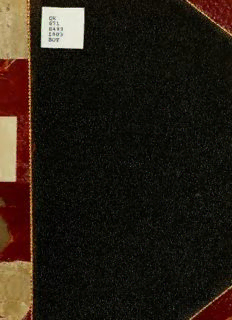Table Of ContentQK
571
S493
1903
BOT
\
SMITHSONIAN
INSTITUTION
LIBRARIES
£Ms£
From the Library of
E. YALE DAWSON
——————
LIBRARY
YALE DAWSON
E.
UNIVERSITY OF CALIFORNIA PUBLICATIONS
BOTANY
Vol. 1, pp. 165-418, Pis. 17-27 March 31, 1903
ALGLE OF NORTHWESTERN AMERICA
BY
WILLIAM ALBERT SETCHELL
AND
NATHANIEL LYON GARDNER
CONTENTS.
PAGE
I. Introduction 167
II.—Geography _ 167
III. History 171
IV. Collections 173
V.—Scope 175
VI.—Citations 176
VII.—Acknowledgments 177
Vni.—G'YANOPHYCEiE 178
LX.—Chlorophyce.£ 199
X.—PHiEOPHYCEiE 233
XI. Rhodophyce^: 286
XIL—List of geographical names 368
XIII. List of works referred to 381
XIV.—Index 388
XV. Explanation of plates 398
:
BOT.-12 [165
ALGLE OF NORTHWESTERN AMERICA.
INTRODUCTION.
No account of anycompleteness, orofpretension towards com-
pleteness, ofthealga?of the northwestern coast of NorthAmerica
has ever been published. Various accounts have been written
and odd references have been made in general and special works,
but nothing- which has brought together all the available mater-
ials. We have been at work for some time trying to obtain
siieh a knowledgeas towarrant the attempt, and in thefollowing
pages we shall try to bring together all that is known to us,
either from specimens or from the literature, of the algae of the
region known as the Northwest Coast. Unfortunately, the spec-
imens from which the earlier accounts are drawn, are all pre-
served, as many as still survive, in various European herbaria
and are. as yet, inaccessible to us. We have tried, however, to
make full use of such study as has been made of these in the
later days and published or communicated to us. While we have
tried to discuss, or at least to mention, every alga credited to
our territory, we have laid the greatest stress upon the results of
our own studies in the field and upon specimens communicated
to us, or otherwise accessible. This account, then, represents
largely our own experience in attempting to obtain a knowledge
of this algal flora.
GEOGRAPHY.
The limits set for this account, from the geographical
point of view, range from Cape Flattery at the northwest-
ern corner of the State of Washington, northward along the
coast to the region of Kotzebue Sound on the Arctic coast of
Alaska. This general region is chosen for several reasons of
algal distribution. The study of the alga? of the entire western
coast of North America has made it fairly plain that there are
four, or possibly five regions of algal growth on the western
[1671
168 University of California Publications. [botany
—
coast of North America, well marked off, viz.; the Boreal,
the North Temperate, the North Subtropical, and the Tropical
Regions. The Tropical Region is almost unknown as regards its
algal inhabitants, but from data existing in our collections,
seems to have its northern boundary somewhere in the neigh-
borhood of Magdalena Bay, on the coast of Lower California in
the Republic of Mexico. It may be characterizedroiighly by the
absence of even the warmer water Laminariacea? and the abun-
dance of Sargassacea?, Dictyotacea?, and other tropical groups.
From the northern limit of the Tropical Region, there extends
northward a Subtropical Region which has its northern bound-
ary fairly sharply marked by Point Conception in Santa Barbara
County in the State of California. This region is characterized
by the presence of Laminariacea? of the warmer waters, such
as species of Eisenia, Pelagophyeus, and Egregia (E. lavigata
Setchell), by certain Dictyotacea?, as well as warmer water
Rhodophyceas, all of which are either strictly limited to the
northward by Point Conception, or else are to be found only in
warmer isolated areas above it. On passing to the north of
Point Conception, a decided change is experienced in the compo-
sition of the algal flora. The groups just mentioned are absent,
and certain species characteristic of the colderwaters to the north
are met with, mingled in certain favored and sheltered localities
with species of warmer waters. None of the strictly subtropical
Laminariacea? are met with, except occasionally the last one
mentioned. No Sargassacea? are found, nor any of the Dictyo-
tacea?, at least none have been found growing. In turn, wemeet
with the Nereocystis of the colder waters, with certain species of
Laminaria, with the northern Egregia (E. Meitziesii (Turner)
Areschoug) and with other colder water forms, less striking,
,
but no less characteristic of this region. The algal flora of the
Temperate Region remains fairly unchanged until we come to
Puget Sound, when we find many of its characteristic species
intermingled with those of the Boreal Region. The species
characteristic of the Boreal Region, extend to some extent, at
least, into PugetSound, interminglingtherewiththespecies ofthe
warmer waters to the southward and the latter, in turn, in some
special cases, extend even farther northward to the region of
Description:of species collected through the courtesy of the Alaska Commercial .. ing looking like Pringsheimia in the specimens distributed. ilme. Weber van Bosse, kindly loaned by F. S. Collins, are balloon-shaped, and measure from 1

